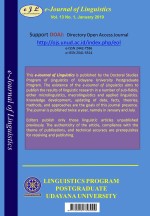The Relationship between Language Learning Strategies used by Vocational Students and Level of Proficiency
Abstract
The vocational college students instructed by the teacher to used self-directed learning in learning English outside classroom or during the internship. Due to the requirement of graduation which they should pass the TOEFL test after the internship. The self-directed learning is exercised by managing students’ Language Learning Strategies (LLS) which known could improve language proficiency. Hereby, this study identifies: (1) the language learning strategy used by vocational college learners based on high and low proficient, (2) the relationship between language learning strategy and English proficiency of high proficient, (3) the relationship between language learning strategy and English proficiency of high proficient. The participant of this study is 52 students of Politeknik Kota Malang which willing to complete the Strategy Inventory of Language Learning (SILL) and done the TOEFL test. This study employed correlational research design to identify the relationship between variables which is multiple regression analysis employed in this study. There are six strategies of language learning strategies by Oxford (1990) as the independent variables (predictors) and English proficiency (criterion) as the dependent variable. The result showed that Although, language learning strategy cannot simultaneously predict the English proficiency of high proficient and low proficient, compensation strategy reported as high frequently used by high proficient learners. While metacognitive strategies reported used by low proficient learners.
Downloads
References
Dornyei, Z and Ryan, S. (2015). The Psychology of The Language Learner Revisited. Newyork: Routledge.
Ary, D; Jacobs, L. C; Sorensen, C. Ks; Walker, D. (2006). Introduction to Research in Education. California: Wadsworth Group.
Alfian. (2018). Proficiency Level and Language Learning Strategy Choice of Islamic University Learners in Indonesia. TEFLIN Journal, Volume 29, Number 1, pp 1-18.
Hao, Y. C & Nai Y. C. (2015). Effects of Language Learning Strategies and Learners’ Motivation on Students’ Learning Achievement. International Journal of English Language Education, Vol. 3, No. 2, pp 132- 143.
Hayati, N. (2015). A Study of English Language Learning Beliefs, Strategies, and English Academic Achievement of the ESP Students of STIENAS Samarinda. Dinamika Budaya: Journal of Education, Vol. 15 (2), pp 297- 323.
Lestari, D., Suastra, I., Pastika, I., Sedeng, I. (2017). Developing A Method of Learning English Speaking Skill Based on the Language Function Used in the Food and Beverage Service. E-Journal of Linguistics, Vol. 11, No. 1, pp 70-79.
Min, H., Pey, C. . (2010). EFL Learners’ Language Learning Strategy Use as a Predictor for Self-Directed Learning Readiness. The Journal of ASIA TEFL, Vol. 07, No. 02, pp 153-176.
Nasihah, M., & Cahyono, B. Y. (2017). Language Learning Strategies, Motivation, and Writing Achievement of Indonesian EFL Students. Arab World English Journal, 8 (1) pp 250- 263. DOI:
Oxford, R. (1990). Language Learning Strategies: What Every Teacher Should Know. Heinle and Heinle Publisher.
Rachmawaty, N., Wello, M. B., Akil, M., Dollah, S. (2018). Do Cultural Intelligence and Language Learning Strategies Influence Students’ English Language Proficiency?. Journal of Language Teaching and Research, Vol. 9, No. 3, pp. 655-663.
Rachmawati, D .L. (2015). Language Learning Strategies Adopted by English for Specific Purpose (ESP) Students in Merdeka University Malang. Malang: Universitas Brawijaya.
Rismayana. (2017). The Correlation Between LLS And Proficiency Level fEnglish Departement Students in UNM. ELITE: English and Literature Journal, Vol. 4, No. 2, pp 37- 50.
Rustam, N. S., Hamra, A., Weda, S. (2015). The Language Learning Strategies used by Students of Merchant Marine Studies Polytechnics Makassar. ELT Worldwide, Vol. 2, No. 2, pp 77-94.
Sabilah, F., Beratha, S., Budiarsa, S., Yadnya, P. (2018). Designing the Intercultural Teaching Using “Dialog Reading” Strategies for English Students at Primary Schools. e-Journal of Linguistics, Vol. 12, No. 1, pp 1-14.
Zhou, C & Intaraprasert, C. (2015). English- Major Pre-Service Teachers’ Language Learning Strategy Use in Terms of Enjoyment English Learning. Journal of Language Teaching and Research, Vol. 7, No. 6, pp. 1103-1110.

This work is licensed under a Creative Commons Attribution 4.0 International License











